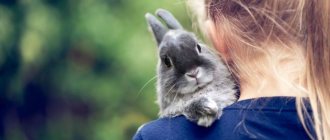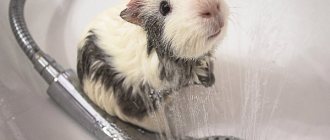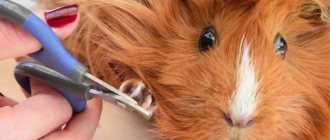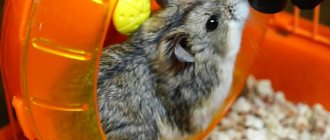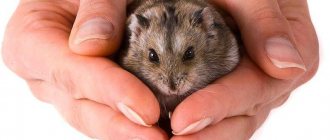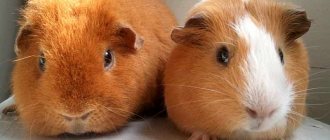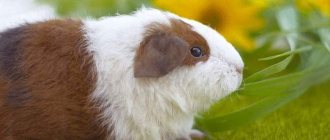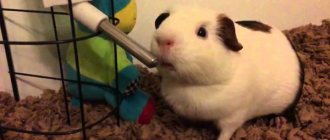The famous trainer Vladimir Durov was the first to train guinea pigs. But you don't need to be a professional to train a rodent. Any owner can teach a pig to respond to its name, go to the litter box, and even perform circus tricks.
And to tame a guinea pig, it is enough to follow the advice of experienced breeders and be patient.
Adaptation to a new place
They begin the taming process only after the animal gets used to its new housing.
In order for this period to pass favorably for the animal, it is necessary to provide suitable conditions for this:
- In the room where the animal's cage is located, you should not make loud, sharp sounds. It is not advisable to install the cage near sources of constant noise. Rodents have very sensitive hearing and a delicate nervous system.
- There should always be water in the drinking bowl, and the feeder should be filled with tasty food. The rodent must be sure that it can drink and eat at any time without being disturbed by anyone.
- A house is immediately installed in the cage, where the pig can hide from prying eyes, or you need to put a large pile of hay.
- Other pets that live in the house should not be introduced to the pig prematurely. They can scare her and it will not be easy to calm her down.
- When cleaning the cage or other manipulations related to keeping a rodent, everything must be done extremely carefully, without sudden movements.
- It’s too early to organize walks around the apartment. The pet does not yet know where the house is and will be scared when they start catching it. He will have the opportunity to begin exploring the surrounding area if there is an aviary next to the cage.
Article on the topic: Why do guinea pigs die at home: signs and causes of sudden death
There is another rule that causes controversy among pig owners; it says that the rodent should not be picked up at first. Each pet already has previous experience interacting with people. If it was successful, the pig will want to feel the hands of the new owner. Cases are described when an animal becomes calmer in your arms. With such animals there will be no problems with training and taming in the future. You can pick up a guinea pig on the first day only if you are absolutely sure that it will not cause rejection.
Most often, at first, the guinea pig will avoid contact and look closely at everything that is happening around.
The pig needs to be provided with visibility and at the same time given the opportunity to hide. Under no circumstances should you insist on affection if she is panicking.
Upbringing
Raising a pig does not begin on the first day it arrives in the house. First, the animal is allowed to get comfortable, tamed, and then shown what is allowed to do in the house and what is strictly prohibited.
You need to tame the animal from the first days of life in the house. For this:
- Immediately after the rodent appears, it is placed in a cage, which is covered with dense material. This way, the pet will not be distracted by visual sensations, but will get used to the sounds and smells.
- At first, the owner should talk to the pet in as calm and gentle a voice as possible.
- After some time, you can offer the animal a treat from your hands.
- After a week, the dense material is replaced with a lighter and more transparent one.
- After another week, the cape on the cage is removed. After this, the owner must leave the room so that the pet can look around.
After taming, you can and should begin raising your pet.
The first thing you need to pay attention to is safety. This applies to both pet and owner. Rodents need to wear down their teeth, so they can chew on any objects they like.
This could be furniture, wires, small things left in its path. To prevent property damage you need to:
Rodents need to wear down their teeth, so they can chew on any objects they like. This could be furniture, wires, small things left in its path. To prevent property damage you need to:
- Monitor your pet's behavior when the animal is on a walk.
- Place the cage in a space free of foreign objects. That is, there should be no things near the cage that the rodent could reach.
- Close the cage carefully to prevent the pig from escaping.
If an animal constantly gnaws on an object while walking, it is recommended to apply a special gel or solution to the favorite item. This product has a bitter taste, but at the same time is absolutely harmless to animals. To wean yourself from damaging things, you need to apply the product regularly.
Taming methods
When it becomes clear that the pet feels confident in a new environment, taming a guinea pig to its owner will not be difficult.
At first you need to talk to her kindly. As soon as it becomes clear that the animal trusts its owner, you can offer treats through the open cage door. At the same time, allow them to examine and smell their hands. Smells are very important to animals.
If the animal takes food from your hands without fear, you can begin to gently stroke it. The back of the body is left untouched so that the animal does not perceive these movements as an attack. First, the pig is petted, reinforcing good intentions with treats; gradually this can be done without food. While stroking, you need to try to understand what exactly the pet likes.
The next step is to take the animal in your arms. Making friends and accustoming him to a litter box will not be difficult if you treat your pet with care, do not cause pain, and understand what he likes.
When handing out a treat, you need to call the pig by name. Once she gets used to this situation, calling her over will be easy. All you have to do is sit down, extend your hand and say the guinea pig's name.
Article on the topic: How to make a rack for guinea pigs with your own hands: instructions and drawings
How to choose the right mating partner
Here's how to choose the right partner for mating:
The best age for a male is from eight months to a year. It’s better not to let old “pigs” into breeding.
It is very desirable that the “groom” belongs to the same breed or at least variety. In this case, there will be much fewer problems with childbirth and pregnancy.
The optimal weight is from 0.7 to 1 kg. The female, by the way, should weigh about the same. The animal should be neither obese nor emaciated.
https://www.youtube.com/watch?v=GsW_Y5o5aZM
Finally, the pet must be completely healthy. To make sure of this, it is advisable to have the “bride and groom” examined by a veterinarian.
It is highly desirable that the animals be approximately the same in character. Two fighters can seriously damage each other’s skins; if you pit a melancholic and active pet, normal mating will not work either.
What to do if your pig is afraid?
Young individuals purchased directly from breeders get used to their owners more easily. Animals from pet stores are usually distrustful and unsociable. Animal behavior depends on how store visitors, owners and sellers treated the animals.
To quickly “melt the heart” of a pet who is afraid of people, you need to hand feed it more often. It is recommended to constantly talk to him. The cage can be temporarily moved closer to the owners. If the pet watches people, over time it will understand that nothing threatens it.
Fear is not always the reason why a pig doesn't want to be held. She may have an independent character or be planning to do something else and is not in the mood for tenderness. Anything is important: clean the paws, drink water, examine the toy. When a pet pulls at its owner's clothes or grabs the skin with its teeth, it doesn't like something. He needs to be released.
It is necessary to distinguish whether the animal is afraid or feels unwell. He runs briskly into the far corner or buries himself in the hay - he’s scared. He sits unkempt and squeaks desperately when someone wants to pick him up - you need to consult a veterinarian.
If a pet spends a long time in its house and does not gain experience interacting with people, it is difficult to imagine that it will quickly get used to its owner. The animal needs to be lured out more often.
Sometimes they practice not installing a house in the cage and make do with hay. But this is cruel to the animal. Every animal should have a private zone.
How to hold in your hands correctly?
In the process of taming a pet, you need to learn how to hold it in your arms correctly. Holding a heavy animal suspended is not an option; it will hurt. The pig will remember this condition and next time it will not be handled.
Article on the topic: How to train a guinea pig at home
The animal is held so that it can lean on the owner - firmly enough, without squeezing, so as not to damage the internal organs. The rodent's physique appears to be strong, but in fact, impacts and falls even from a small height lead to serious injuries and death.
When a completely trusting relationship develops between the pet and the owner, you can begin playing and training together.
Plaid toys
When choosing entertainment accessories for your cage, you should remember that they should not be large and clutter up the space of the cage.
Guinea pig toys are easy to make
You can offer your pet:
- tennis balls or ping pong balls
. Guinea pigs love toys that can be rolled on the floor by pushing them with their paw or head, so your pets will definitely like these balls; - Children's game blocks
made of wood are also suitable for this purpose Animals will not only play with them, but also use them as an additional teeth sharpener; - Rodents will also be interested in a tube from a used roll of toilet paper
or paper towels; - You can please your pet with a small soft toy
. He will sniff her with interest and drag her into his house. You just need to make sure that the animal does not make large holes in the toy. If the stuffing sticks out of the item, it should be replaced with a new one; - Guinea pigs will not remain indifferent to such a thing as a rope on which a treat or a sharpening stone is strung. The object is placed on the floor of the cage and after the animal has played enough with it, it will eat a treat or gnaw on a mineral stone.
Important points
It is much easier to find a “common language” with a pig if you know its preferences:
- Noises or loud noises disturb the animal and make it nervous and unpredictable.
- Dry grass or litter should always be clean and fresh in the cage, as the pig loves to burrow into it.
- The diet must include fresh vegetables and fruits, greens; these are not only vitamins, but also support the digestion process.
- The room should be comfortably warm; pigs do not like drafts.
- It is necessary to accustom your guinea pig to the toilet in one place if it does not immediately find its way.
It takes a very long time for a pig to get used to eccentric people with a loud voice and lively gestures. She is afraid of this behavior because she sees it as a threat.
Guinea pigs are not suitable for families where there is constant noise, with the TV or music turned up at full volume. This must be remembered when choosing this rodent as a pet.
Adaptation to a new place
Until the animal feels completely safe, all attempts to tame a guinea pig will be in vain. Therefore, in such an important matter, you need to be patient, provide your pet with comfortable and calm conditions, and wait until he gets used to the new living conditions.
Article on the topic: American Teddy Guinea Pig - photo and description of the breed
First of all, some conditions must be met:
- You cannot make noise near the cage;
- the drinking bowl and feeder should always be full;
- you need to arrange a shelter: a heap of hay behind which the animal will hide;
- the new resident must be isolated from other pets;
- people do not need to pet or forcibly hold the animal in their arms.
At first, the animal will naturally try to avoid contact with people. In the presence of strangers, the pet may even refuse food.
To facilitate the adaptation process, you can cover the cage or enclosure with a thin cloth.
Even if the pet does not show its anxiety, the owner must be as delicate and careful as possible.
The animal should not be disturbed for no reason, it should not be picked up, and there should be no sudden movements when cleaning the enclosure. In the first days of living in a new place, it is not recommended to let the animal walk around the apartment, because it may not find its way back. And the process of catching will lead to stress for the pet.
Training
Guinea pigs are trained using treats as rewards. During training, you should not make sudden movements or make loud sounds. Most pigs are able to learn only the simplest commands, while some animals are easy to train and perform more complex tricks.
Stand
This trick can be taught to almost any animal. When the rodent is in a good mood, it must be placed on a flat surface. A treat is placed above his head. Then in an even voice you must repeat “Stop!” (can be replaced with “Serve!”). The animal will notice that after completing the command it receives a treat, and will be willing to carry it out.
Call
In just a couple of weeks, you can train a pig to respond to its name and come when its owner calls. You will also need some goodies for training. The animal is placed on a flat surface at a distance of a meter and, showing a treat, is called to you. When the pet reaches the goal, it must be rewarded. It is recommended to perform the workout daily. The distance can be increased gradually. In order for the animal to respond to its name and remember it faster, it is necessary to call the pet by name as often as possible.
U-turn
The U-Turn trick can be performed in a cage or on the floor. You must take the treat in your hand and draw a circle over the animal’s head (preferably clockwise), accompanying your actions with the command “Turn!” or “All around!” The animal must repeat the movement of the owner's hand in order to receive the treat. You can get used to a full turn gradually. First, reward your pet for turning 45⁰, then 90⁰, and so on.
Kiss
This simple trick can be taught to any rodent. You will need your pig's favorite treat and a little patience. A piece of treat is placed on the owner's lips. The pet rises to the level of the owner's head and, sensing food, reaches for his face.
Give me your paw
This command is more difficult than the previous ones. For training, you need to place the pig on the sofa. The owner sits on the floor and extends his left hand to the piglet, palm up, at the level of the sofa. There is a treat in the right hand, and the owner uses it to lure the guinea pig. Without allowing the pet to move forward much, you need to wait until he puts his paw on the open palm of the owner, and give a treat, saying the command: “Give me your paw!” To achieve success, you will have to work with the rodent regularly.
Roll the ball
To learn this trick you will need:
- tennis ball (you can use another small ball);
- a stick-shaped treat (a strip of carrot or celery).
The treat is placed on the floor and a ball is placed on it. To get the treat, the pig needs to push the ball. When she shows interest in the items offered to her, you must say: “Push the ball!” To achieve results, the exercise is performed regularly.
Jump through the ring
To carry out the command, you need to prepare a ring with a diameter of 15-25 cm. You can use a ready-made one or make a hoop yourself from wire. You can also adapt a tennis racket without a fishing line and other similar items. The edges of the device must be smooth.
The ring is positioned so that its edges touch the floor. A treat is placed on one side of the circle, and a guinea pig on the other. The owner gives the command “Ring!” and lures the pet with goodies. You can gently push the animal if it does not move on its own. When the animal passes the obstacle, it needs to be praised and treated. The hoop gradually rises from the floor, but not higher than 3 cm.
Taming methods
Over time and with the proper approach, the pet gets used to the person and is less afraid. After complete adaptation to the new place of residence, you can continue to tame the animal. In this case, the time spent can be very different, everything will depend on the nature of the pet.
Getting used to the owner
You can tame a guinea pig to its owner in stages:
- The owner should constantly talk to the pet in a gentle and calm voice, while simultaneously offering the animal treats.
- As soon as the animal begins to calmly react to the presence of a person, they move on to taming it by hand. To do this, open the cage door and offer the pet a treat, at the same time allowing you to sniff your hands.
- When the animal begins to calmly accept treats from human hands, you can try to slowly stroke it. However, to prevent your pet from perceiving your actions as aggression, you should not touch his rump.
- A little later, you can pet the animal without giving it a treat. It will gradually become clear whether the animal likes such actions or not.
- After mastering stroking, you can begin to pick up your guinea pig.
- In order for the adaptation to the owner to go smoothly, it is recommended to avoid situations that are unpleasant for the animal. Try to avoid actions that cause any discomfort to your pet.
- The cavey should be handled correctly, held and stroked in such a way that it feels good.
Article on the topic: Can guinea pigs eat avocado, pineapple, mango and kiwi?
Getting to know the toilet
Many people are convinced that it is impossible to litter train a guinea pig. However, this opinion is wrong. Rodents have developed intelligence to understand where to defecate.
There are many different types of trays for pigs, but they are usually containers with a hole so that the animal can freely climb inside.
You can toilet train your guinea pig using granular litter.
It compares favorably with other materials in that it perfectly absorbs moisture. This means that such a filler will have to be changed quite rarely, thereby disturbing the pig less.
One of the most important points is choosing the optimal location for the toilet. You need to take a close look at the animal and understand where it goes all the time. It is recommended to place the toilet in this place.
Place some used litter in the tray. When the animal wakes up, you need to put it in front of the tray. By smell, he will quickly determine what the structure is intended for. If the animal refuses to go to the designated place, then you can install several toilets at once so that the animal chooses the one it likes. In this matter, it is very important to be patient, because gradually the pet will understand what’s what.
What to do if your pig is afraid
Undoubtedly, it is easier to make friends with a young animal than with an adult. Adult pigs take a long time to get used to people.
Animals bought in a store are usually not sociable, because buyers do not always demonstrate friendliness and tact in treating them.
To avoid frightening the animal, try offering him treats only from your hands. It is also very useful to have conversations with your pet, sitting him on your lap and stroking him.
It’s good to place the cage for a while closer to the owner’s favorite place. Constantly being in the company of the owner, the pet will understand that there is no threat from this side.
However, cavey does not like to be held, not only because of fear. The reason may be independence and love of freedom. Keep in mind that not every pet wants to sit on your lap. If he bites his owner's clothes or skin with his teeth, it means he is uncomfortable.
Article on the topic: Temperature of keeping guinea pigs at home
It happens that a pet does not go to hand for a long time due to the fact that there is a house in the cage. Behind its solid walls the pig feels safe.
People who talk loudly and gesticulate intensely can frighten a guinea pig. Animals feel threatened by this behavior.
A hunched posture may not be due to fear, but to poor health. If this behavior is noticed in your pet, it is recommended to immediately consult a veterinarian.
Necessary for care
Like any other pet, a guinea pig requires a wide variety of grooming accessories. These include:
- cage or aquarium;
- feeder;
- sippy cup;
- house;
- filler;
- mineral stone;
- toys;
- carrying;
- hygiene products;
- brush-comb and nail clipper.
Cage or aquarium
Keeping a guinea pig is allowed both in an aquarium and in a cage. The main condition is size: the dwelling must be at least 50 cm in length and 30 cm in height so that the animal can move comfortably. If you have decided on a cage, then it is best to take a closer look at the options that have a plastic bottom. Plastic is quite easy to care for, it is easy to wash, dry, etc. A wooden base is not suitable due to the fact that these animals drink a lot of liquid per day, and therefore excrete a large amount of urine. The wood will simply become unusable in a very short time. You can purchase an aquarium in the above sizes. It, like a cage with a plastic bottom, is easy to wash and clean. But you should be careful, since glass is a very fragile material and when moving it, for example, to another room, you should follow safety rules (the pet should not be in the aquarium, it should be transferred to a carrier).
cell
Feeder
The feeder should be heavy enough so that the guinea pig cannot knock it over. An excellent option would be bowls made of ceramics, stainless steel, etc. It is also recommended to buy 2-3 containers. For example, one will be used for vegetables or fruits, and the second for dry food.
Sippy cup
A vertical ball sippy cup is perfect for a guinea pig. It is usually made of plastic with a metal tip. In such a drinking bowl there is no need to change the water daily, but this is done about 2-3 times a week.
House
Be sure to install a small house in the cage or aquarium. Your pet will sleep in it, relax, or simply retire when he wants to be alone. Most often, such houses are made of wood with a round “door” cut out in the middle. The most optimal size is 25 cm in length and 15 cm in height. This space is enough for the animal to hide and at the same time feel comfortable.
house
Filler
When arranging the cage, do not forget about the bedding. It will create comfort in the cage, prevent the animal from freezing and, to some extent, maintain cleanliness. You can use sawdust or ground corn cobs as a filler. Under no circumstances put cotton wool, newspaper, paper, etc. in the cage as bedding, as this is not safe for your pet’s health.
Mineral stone
To maintain dental health and calcium levels in your guinea pig's body, mineral stone is essential. After all, it serves not only as a vitamin complex, but also perfectly helps the animal grind its teeth. This stone is sold in a pet store, and its price is quite affordable.
stone
Toys
Guinea pigs are somewhat similar in behavior to decorative rabbits. They love to play. Therefore, be sure to buy some interesting and funny toy for your pet, for example, a tunnel, a hammock, a mirror, a rolling wheel, etc. The game will not only bring joy and pleasure to the animal, but will also strengthen muscles, and will also be an excellent preventive measure against obesity.
Carrying
If your plans did not include traveling together or any trips with your guinea pig, then you will still need a carrier. Transporting an animal in your arms, in a box or blanket is strictly prohibited. For example, you need to visit a veterinarian or transport the animal to another house or apartment; in such life situations, a carrier will definitely help you out. The pig will feel safe and the transportation process will go smoothly.
Hygiene products
Guinea pigs are considered clean animals, but sometimes they are still allowed to be bathed. For such cases, it is necessary to use special hygiene products that can be purchased at a pet store. The most popular of them:
- "Biogance" - bio-perfume;
- "Veda" - wheat shampoo.
Brush-comb and nail clipper
Caring for your guinea pig's coat and claws is extremely important. To do this, you need to purchase a special comb with soft bristles (combing is done daily), as well as a nail clipper for trimming the claws (the procedure is performed as they lengthen).
Favorite caresses for a guinea pig
When petting your pet, pay attention to its reaction. Many pigs simply love to have the bridge of their nose stroked, their neck and the area behind the ears scratched. But if an animal pushes the hand stroking it with its head, it means it doesn’t like something. Guinea pigs also enjoy being petted on their barrels, just like cats. However, such caresses
The animal usually only allows it to a person whom it trusts completely and completely. Therefore, at the first stage of dating, such caresses are unacceptable.
Like dogs, pigs love affection, especially when they are petted and scratched near the ears. This area is highly sensitive, so don't overdo it. Monitor your pet's reaction until he puts your hand under your arm and you can safely continue.
How to hold a pig correctly
It is very important to learn how to properly hold an animal in your arms. Although this animal is small in size, it is relatively heavy. Therefore, if you hold him up, it may hurt him. Therefore, he must be able to rely on the owner.
So, let's learn how to hold a guinea pig in your arms correctly:
- one palm is placed behind the front paws, clasping the chest;
- with the other hand, carefully support the back;
- you need to hold the animal tightly, but not too squeezing.
The Cavie's build is not at all conducive to striking. A fall, even from the smallest height, can cause severe bruising, injury and lead to the death of your pet.
Reproduction
The female is ready to reproduce offspring already at the 5th month from birth, the male guinea pig at the 6th. But breeders recommend that the first matings be carried out no earlier than the pets are 10 months old. Animals of the same breed and age that are not related to each other are chosen as parents. Obese individuals are not suitable for reproduction.
Females are ready to breed every two weeks or month for two days. 10 days before the onset of estrus, vitamin E is added to the female’s diet. It is best if the female becomes pregnant no later than November, then she will have time to feed her offspring before the onset of molting. Molting is a difficult process for an animal; in combination with feeding, it puts a lot of stress on the female’s body.
It is easy to determine that a female is ready to mate. She lifts the back of her body, spreading her paws to the side.
Fertilization occurred if the female did not start another estrus within 20 days. Then she is transplanted into a separate cage.
The female's pregnancy lasts 10 weeks. At this time, you don’t need to carry her in your arms, often take her out of the cage and fiddle with her unnecessarily. Excess stress can lead to miscarriage.
Mother pigs can develop toxicosis. It occurs in the period before and immediately after childbirth. At this time, females experience muscle cramps, loss of appetite, deterioration of coat condition, and drooling. Toxicosis can be avoided if you make the right diet, add vitamins and prevent stress. Toxicosis also occurs due to pregnancy with many children. Females usually give birth to 3 to 5 piglets.
Guinea pigs usually give birth as usual and last about half an hour. Newborns can see and hear and also have incisors. 2 days after birth, they can already eat regular food. And when they are a month old, they can be moved into a cage for further independent life.
Before getting a guinea pig, study information about these cute rodents. Caring for the animals will be easy for novice breeders. However, the owner is responsible for the health and well-being of his pet. After all, only a healthy animal will be cheerful and playful and bring joy to its owner.
Important nuances
Before taming a guinea pig, carefully study its behavior and mental characteristics. Undoubtedly, animals love:
- Peace and quiet. In a noisy environment, animals become restless, irritable and even aggressive. Working with an animal in such conditions is completely useless.
- The presence of a large amount of hay in the cage. Guinea pigs just love to burrow into the grass.
- Juicy vegetables and fruits, as well as a variety of greens, contain useful microelements that strengthen the immune system.
Article on the topic: Guinea pig of the Self breed (English) - photo and description
Some breeds of pigs are very picky about the temperature conditions in the room, they get cold and often catch colds. And when the pet feels any discomfort, taming classes are out of the question. You should never start playing with your guinea pig until it is accustomed to its new environment.
But when the animal’s adaptation is successful, when it is possible to tame the pet, the owner will find a faithful friend who will delight the owner and family members with games and tricks for many years.
Training rules
There are no special secrets in pig training - after all, its main principles are:
- owner's patience;
- constancy;
- subsequence;
- reward items - treats.
Did you know? All rodents are very clean creatures. They look after not only themselves, but also their relatives.
So, the first rule is to observe your pet’s normal behavior. Just sit nearby and see what your guinea pig tends to do.
The second rule requires the presence of a signal source, treats and silence. When the animal does what you want, you should blow the whistle (you can choose any suitable signaling device) and give the animal a treat. By doing this, a person gradually reinforces the reflex behavior of a furry creature.
Find out also how much guinea pigs cost.
What food options are suitable as incentives? They become all the foods that your pig loves most. Does she chew carrots with pleasure? Prefers to chew on something else? Together with her, choose the best treats. Let her be happy to receive them.
Video: Guinea pig training
Basic content rules
Pigs love communication, so you shouldn't keep them alone. It is better to take two same-sex animals. The cage should be spacious; filler should be poured onto the bottom, which changes as it gets dirty. Be sure to place a bowl, a drinking bowl and a house in the home - the rodent needs all this for a full-fledged existence. Trim your pet's nails regularly to prevent them from bending and growing into the paw. The pigs should be washed as needed, and after water treatments, they should be dried thoroughly so that they do not get sick.
Take two pigs into your family, as they love communication and one pig will be bored
Animals should be able to grind down their constantly growing teeth; to do this, place a mineral stone or tree branches in the cage. For entertainment, you can install labyrinths, swings, tunnels and other toys.
If you have a guinea pig, you can limit yourself to feeding it and not touch the animal with your hands at all. But in this case, he will not receive the necessary care and attention. These rodents are very sociable animals, and they definitely need company. The best option is the owner. But to do this, you need to gain the trust of the rodent and tame it. This is the only way to establish contact and enjoy spending time together.
Related article: Frequently asked questions about pet rats
How to make a house from a cardboard box
You don't need any special skills to make a nest in a cardboard box. You need to take a shoe box and small household appliances. Holes for entry and exit are cut out in the walls, and windows on the remaining walls. You can stop here and invite the animal to a new home. In a cage, the box is placed upside down. This must be taken into account when cutting out the entrance and windows. If there is no floor, there is no need to remove garbage separately in the house.
The advantages of cardboard housing are the simplicity and minimal cost of its production, as well as the environmental friendliness of the material. But at the same time, cardboard is short-lived and has a high absorption of odors, and also gets dirty quickly. Cardboard cannot be washed. But you can change your old home to a new one without much effort.
The pig will also like a house made from a paper bag. You just need to put the bag on its side. Hay is placed inside the house to support the entire structure. But this is a one-time option, since the paper will quickly get wet and tear, and besides, the pet will quickly chew this material.
Reasons for pet alienation
Pigs are sociable animals, they love to play with each other and communicate with their owner. But sometimes there is no trace of their friendliness. There are several reasons for this:
- the rodent was bought at a pet store;
- the animal has diseases;
- the animal feels threatened;
- change of usual environment.
When a guinea pig is brought into the house, children and adults want to play with it and cuddle it in their arms. It is highly undesirable to do this in the first days. Give your pet time to adapt, especially if he lived in a pet store and does not know people. The move and the increased attention from others can cause him shock. For all animals, the process of habituation takes place differently: for some, a few hours are enough, for others it takes days. In any case, if the pig is hiding and hiding in a corner, leave it alone.
The animal should be shown to a veterinarian so that the correct solution can be prescribed.
One of the reasons for alienation is illness. In this case, you need to urgently consult a veterinarian and only after recovery begin taming your pet. During physical education and punishment for misdeeds, the animal can behave hostilely. The fact is that he cannot understand the connection between his behavior and violence on your part. Therefore, any actions are perceived negatively. Moving to a new place causes stress in the pig, which can make it difficult to communicate. Be patient for a while and everything will return to normal. If none of the above points suits you, and your pet has been living in an apartment for a long time, he clearly lacks attention, and it’s time for you to start educational activities.
How to understand what your pet wants?
Squeaking is a way of communicating with relatives and humans. Guinea pigs have a wide range of sounds, each of which means something. Over time, every owner of a pet rodent begins and must learn to understand the language of a small pet. Let's try to understand some of them.
A persistent, incessant squeak at intervals of one or two seconds indicates the pet’s obvious hunger. Compassionate - speaks of fear or fear in cubs
Older pigs that are kept alone are trying to attract attention and have some fun. Cooing somewhat reminiscent of the clucking of a hen - the pig is well-fed, happy with life and is in a great mood - for her at this moment the world is beautiful and impeccable
“Grunting” is an expression of friendliness when meeting other relatives. The same sound can mean that the pig is busy with something very exciting. Growling - this basically indicates the pet’s fear of an opponent who is stronger than him. By the way, this opponent can also be a person - that’s why a guinea pig squeaks when you pet it. Having heard a menacing, or rather frightened roar, accompanied by the clicking of teeth, it is better to leave the pet alone before he uses his sharp teeth; The rattling purr indicates mating games - this is how the male attracts the attention of the lady of his heart and courts her. If suddenly the female has no desire to communicate with the opposite sex or she is not ready for mating, then in response she will begin to bare her teeth and growl. A piercing loud sound that you wouldn’t expect to hear from such a small creature, more like a groan, a way of talking about pain. You cannot ignore such a squeak, otherwise you may pay with the life or health of the baby.
Guinea pigs are interesting and even mysterious creatures that give the joy of communication to their owners. By learning to understand and feel furry rodents, you can always achieve perfect harmony in the relationship between pet and person.
Main stages of taming
If you don't know how to tame a guinea pig, start by giving it at least fifteen minutes every day. Gradually she will get used to you and begin to show interest. In addition, you can apply a few simple techniques. The main thing is to do everything step by step.
First stage
Once in a new home, the animal encounters new objects and smells that greatly frighten it. Therefore, do not pick up your pet immediately or even try to pet it. Leave him alone for a while, protect him from noise. It usually takes rodents a week to get comfortable in an unfamiliar place.
Article on the topic: Why does a guinea pig jump, twitch and shake its head - popcorning (video)
For successful acquaintance, you need to approach the animal’s cage at least eight times a day and talk to it in a calm voice.
Approach the cage with the pig and try to talk to it
You can open the door and give the animal a treat. Trying to try it means that it is ready to communicate with you. Do not rush to put a house in your home, otherwise the rodent will constantly hide in it. It is better to put sawdust or straw at the bottom of the cage - this way the pig will feel safe.
Second stage
At the next stage of taming, you need to win the pet's love and trust. This is not as easy to do as it might seem at first glance. Often, once in the hands of the owner, the animal chatters its teeth - this is how fear manifests itself. Therefore, it is not recommended to start communication with such close contact. To begin, hand the rodent a treat through the bars of the cage, preferably doing this at the same time. Over time, your pig will associate your smell with a pleasant process and will make contact more easily. The daily diet is presented in the table:
Food is a great way to earn an animal's trust. At first it will not eat from your hands, so leave the treat in the cage and move away. Try again the next day.
It is necessary to feed the pig tasty food
Gradually, the animal will understand that you are a friend, water and feed it, and will overcome its fear. And in a week he will boldly approach the bars and eagerly wait for you.
Next steps
There are several minor stages that are of great importance. They allow you to quickly tame a pig. This may include:
It is necessary to stroke the pig, pick it up
When your pet starts eating from your palms, you can try to establish direct physical contact with him - try patting the baby on the head. If he doesn't show concern and doesn't try to bite you, you can walk all over your back. But you cannot grab a rodent by its lower part - this is how a predator grabs animals in their natural habitat. Also, do not wave your arms or hang over the baby with your whole body - this will only scare him. When close contact has been established, you can carry out water procedures - it will help remove dirt and unpleasant odors.
Article on the topic: How to make a cage for a guinea pig with your own hands at home - drawings and photos
Final stage
When the pig gets used to you, stops being scared and remembers your name, you can begin training. This is the next step in how to hand train a guinea pig. Your pet can be taught to go to the toilet and perform simple tricks. If you fail, do not yell at the rodent under any circumstances. Be patient and you will succeed.
If your guinea pig trusts you completely, try playing with him, making sure to reward him with treats. There are several interesting things to do:
- Pushing the ball - using the reflex to push away objects, you can teach the animal to roll the ball.
- Hello - training to wait and meet the owner at the cage door.
- Dancing – train the animal to raise its front legs up after the word “dance”. Don't forget to treat him with something tasty.
- Kisses – put a treat in your mouth and bring your pet to it. Having smelled the smell, he will grab a piece of the prize with his teeth. By moving food from palm to shoulder and saying the appropriate command, you can teach the rodent to move along the arm.
Guinea pigs are sociable animals. If you pay attention to them, show love and care, they will definitely reciprocate your feelings.
Why tame a pig?
A guinea pig, when it first finds itself in a new home and an unusual unfamiliar environment, experiences stress, anxiety and fear. In this state, it will be difficult for the animal to contact people, preferring to be alone over fun games, training and communication. An untamed animal usually does not allow itself to be stroked or held, striving to quickly hide in its house. A frightened animal may even bite, thus showing a defensive reaction.
Taming a pet is the process of domesticating an animal, which will help establish friendly contact between a person and a guinea pig. By taming an animal, the owner will be able to gain the trust of the baby and create a favorable atmosphere in which the pet will feel comfortable living.
Important. The process of domesticating a pet can take from one to several weeks, depending on the nature of the animal and the environment, so it is very important to approach this matter with patience and understanding.
Important nuances
Before taming a guinea pig, you need to study the characteristics of its psyche and behavior. All rodents love:
- Peace and quiet - noise or sharp sounds make the animal restless and even aggressive. In such conditions, classes will not bring positive results.
- An abundance of dry grass or litter in the cage - animals love to burrow into it.
- Fresh vegetables, herbs and fruits - they contain valuable elements that improve the health of the animal.
Some breeds are sensitive to temperature, get cold easily and can get sick. And when the rodent experiences discomfort, you can forget about taming. Never play with your guinea pig until it has become comfortable in its new environment. When you manage to tame a pet, you will receive a faithful friend in him and will be able to enjoy communicating with him.
Sources:
https://homjakam.ru/morskaya-svinka/priruchat-k-rukam https://msvinkam.ru/soderzhanie/priruchit-morskuyu-svinku-k-rukam.html https://petse.ru/gryizun/morsk_svin/ kak-priruchit-morskuyu-svinku-k-rukam.html


